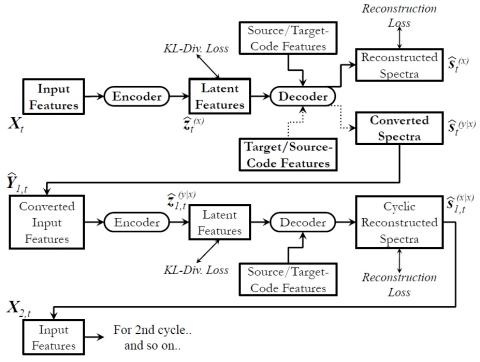In this paper, we present a novel technique for a non-parallel voice conversion (VC) with the use of cyclic variational autoencoder (CycleVAE)-based spectral modeling. In a variational autoencoder(VAE) framework, a latent space, usually with a Gaussian prior, is used to encode a set of input features. In a VAE-based VC, the encoded latent features are fed into a decoder, along with speaker-coding features, to generate estimated spectra with either the original speaker identity (reconstructed) or another speaker identity (converted). Due to the non-parallel modeling condition, the converted spectra can not be directly optimized, which heavily degrades the performance of a VAE-based VC. In this work, to overcome this problem, we propose to use CycleVAE-based spectral model that indirectly optimizes the conversion flow by recycling the converted features back into the system to obtain corresponding cyclic reconstructed spectra that can be directly optimized. The cyclic flow can be continued by using the cyclic reconstructed features as input for the next cycle. The experimental results demonstrate the effectiveness of the proposed CycleVAE-based VC, which yields higher accuracy of converted spectra, generates latent features with higher correlation degree, and significantly improves the quality and conversion accuracy of the converted speech.
Conclusions
We have presented a novel framework to improve conventional VAE, for a non-parallel VC, by using a cycle-consistent flow, i.e., the proposed CycleVAE. Specifically, the converted spectra, which is not directly optimized, is recycled back into the system, to generate cyclic reconstructed spectra that can be directly optimized. The cyclic flow can be continued by feeding the cyclic reconstructed features back into the system. The experimental results demonstrate that the proposed CycleVAEbased VC yields higher correlation degree of latent features and more accurate converted spectra, while significantly improves the quality and conversion accuracy of the converted speech. Future work includes development of many-to-many VC, and incorporates the use of discrete latent space, better prior, i-vector, additional classifier network, and neural waveform generator to produce naturaly sounding converted speech with the proposed CycleVAE.

